Application of Near Infrared Hyperspectral Imaging Technology in Purity Detection of Hybrid Maize
Abstract
1. Introduction
2. Materials and Methods
2.1. Samples
2.2. Experimental Equipment
2.3. Data Processing and Modeling Methods
2.3.1. Multivariate Scattering Correction
2.3.2. Principal Component Analysis
2.3.3. Partial Least Squares-Discriminant Analysis
2.3.4. K-Nearest Neighbor Algorithm
2.3.5. Naive Bayes
2.3.6. Random Forest
2.3.7. Support Vector Machine
3. Results and Discussion
3.1. Background Segmentation
3.2. Spectral Curve Analysis
3.3. Characteristic Wavelength Selection
3.4. Machine Learning Modeling
3.4.1. Discriminant Models Based on the Full-Band Spectra
3.4.2. Discriminant Models Based on the Characteristic Band Spectra
3.5. Model Accuracy Evaluation
4. Conclusions
Author Contributions
Funding
Institutional Review Board Statement
Informed Consent Statement
Data Availability Statement
Conflicts of Interest
References
- Tenaillon, M.I.; Charcosset, A. A European Perspective on Maize History. C. R. Biol. 2011, 334, 221–228. [Google Scholar] [CrossRef]
- Liu, L.; Wang, Y. Brief Analysis of Maize Seed Purity Electrophoresis Identification. Seed World 2000, 1, 21. [Google Scholar]
- Chen, L.T.; Sun, A.Q.; Yang, M.; Chen, L.L.; Li, X.; Li, M.L.; Yin, Y.P. Seed Vigor Evaluation Based on Adversity Resistance Index of Wheat Seed Germination Under Stress Conditions. Chin. J. Appl. Ecol. 2016, 27, 2968–2974. [Google Scholar]
- Radanović, A.; Sprycha, Y.; Jocković, M.; Sundt, M.; Miladinović, D.; Jansen, C.; Horn, R. KASP Markers Specific for the Fertility Restorer Locus Rf1 and Application for Genetic Purity Testing in Sunflowers (Helianthus annuus L.). Genes 2022, 13, 465. [Google Scholar] [CrossRef] [PubMed]
- Yang, L.; Lü, Q.; Zhang, H. Experimental Study on Direct Harvesting of Corn Kernels. Agriculture 2022, 12, 919. [Google Scholar] [CrossRef]
- Izabel, C.S.N.; Edila, V.D.R.V.P.; Viviane, M.D.A.; Heloisa, O.D.S.; Danielle, R.V.; Renzo, G.V.P.; Maria, L.M.D.C. Enzyme Activities and Gene expression in Dry Maize Seeds and Seeds Submitted to Low Germination Temperature. Afr. J. Agric. Res. 2016, 11, 3097–3103. [Google Scholar] [CrossRef]
- Zhang, T.; Sun, Q.; Yang, L.; Yang, L.; Wang, J. Vigor Detection of Sweet Corn Seeds by Optimal Sensor Array Based on Electronic Nose. Trans. Chin. Soc. Agric. Eng. 2017, 33, 275–281. [Google Scholar]
- Fatonah, K.; Suliansyah, I.; Rozen, N. Electrical Conductivity for Seed Vigor Test in Sorghum (Sorghum bicolor). Cell Biol. Dev. 2017, 1, 6–12. [Google Scholar] [CrossRef]
- Siesler, H.W.; Ozaki, Y.; Kawata, S.; Heise, H.M. Near-Infrared Spectroscopy: Principles, Instruments, Applications; John Wiley & Sons, Incorporated: Hoboken, Germany, 2002. [Google Scholar]
- Huang, M.; Wang, Q.; Zhu, Q.; Qin, J.; Huang, G. Review of Seed Quality and Safety Tests Using Optical Sensing Technologies. Seed Sci. Technol. 2015, 43, 337–366. [Google Scholar] [CrossRef]
- Norris, K.H. History of NIR. J. Near Infrared Spectrosc. 1996, 4, 31–37. [Google Scholar] [CrossRef]
- Lohumi, S.; Mo, C.; Kang, J.S.; Hong, S.J.; Cho, B.K. Nondestructive Evaluation for the Viability of Watermelon (Citrullus lanatus) Seeds Using Fourier Transform Near Infrared Spectroscopy. J. Biosyst. Eng. 2013, 38, 312–317. [Google Scholar] [CrossRef]
- Ambrose, A.; Lohumi, S.; Lee, W.; Cho, B.K. Comparative Nondestructive Measurement of Corn Seed Viability Using Fourier Transform Near-infrared (FT-NIR) and Raman Spectroscopy. Sens. Actuators B Chem. 2016, 224, 500–506. [Google Scholar] [CrossRef]
- Kong, W.; Zhang, C.; Liu, F.; Nie, P.; He, Y. Rice Seed Cultivar Identification Using Near-Infrared Hyperspectral Imaging and Multivariate Data Analysis. Sensors 2013, 13, 8916–8927. [Google Scholar] [CrossRef]
- Tang, J.L.; Miao, R.H.; Zhang, Z.Y.; Xin, J.; Wang, D. Distance-based Separability Criterion of ROI in Classification of Farmland Hyper-spectral Images. Int. J. Agric. Biol. Eng. 2017, 10, 177–185. [Google Scholar]
- Wang, S.N.; Tan, Y.; Liu, C.Y.; Song, S.Z.; Li, Z. Classification and identification of soybean varieties by density functional theory combined with Raman spectroscopy. J. Sens. Technol. Appl. 2022, 10, 177–186. [Google Scholar]
- Jia, S.Q.; Liu, Z.; Li, S.M.; Li, L.; Ma, Q.; Zhang, X.D.; Zhu, D.H.; Yan, Y.L.; An, D. Study on Method of Maize Hybrid Purity Identification Based on Hyperspectral Image Technology. Spectrosc. Spectr. Anal. 2013, 33, 2847–2852. [Google Scholar]
- Rui, Y.K.; Luo, Y.B.; Huang, K.L.; Wang, W.M.; Zhang, L.D. Application of Near-Infrared Diffuse Reflectance Spectroscopy to the Detection and Identification of Transgenic Corn. Spectrosc. Spectr. Anal. 2005, 10, 49. [Google Scholar]
- Wang, L.G.; Wang, L.F. Variety iIdentification Model for Maize Seeds Using Hyperspectral Pixel-level Information Combined with Convolutional Neural Network. Natl. Remote Sens. Bull. 2021, 25, 2234–2244. [Google Scholar]
- Qiu, G.; Lü, E.; Wang, N.; Lu, H.; Wang, F.; Zeng, F. Cultivar Classification of Single Sweet Corn Seed Using Fourier Transform Near-Infrared Spectroscopy Combined with Discriminant Analysis. Appl. Sci. 2019, 9, 1530. [Google Scholar] [CrossRef]
- Baranowski, P.; Mazurek, W.; Pastuszka-Woźniak, J. Supervised Classification of Bruised Apples with Respect to the Time After bBruising on the Basis of Hyperspectral Imaging Data. Postharvest Biol. Technol. 2013, 86, 249–258. [Google Scholar] [CrossRef]
- Menesatti, P.; Zanella, A.; Andrea, S. Supervised Multivariate Analysis of Hyper-spectral NIR Images to Evaluate the Starch Index of Apples. Food Bioprocess Technol. 2009, 2, 308–314. [Google Scholar] [CrossRef]
- Zhang, L.; Wu, J.Z.; Li, J.B.; Liu, C.L.; Sun, X.R.; Yu, L. Rapid and Non-destructive Determination of Moisture Content of Single Maize Seed by Near Infrared Spectroscopy Based on Random Forest. J. Chin. Cereals Oils Assoc. 2021, 36, 114–119. [Google Scholar]
- Benković, M.; Jurina, T.; Longin, L.; Grbeš, F.; Valinger, D.; Jurinjak Tušek, A.; Gajdoš Kljusurić, J. Qualitative and Quantitative Detection of Acacia Honey Adulteration with Glucose Syrup Using Near-Infrared Spectroscopy. Separations 2022, 9, 312. [Google Scholar] [CrossRef]
- Isaksson, T.; Naes, T. The Effect of Multiplicative Scatter Correction (MSC) and Linearity Improvement in NIR Spectroscopy. Appl. Spectrosc. 1988, 42, 1273–1284. [Google Scholar] [CrossRef]
- Wang, B.; Zhang, J. Principal Component Regression Analysis for lncRNA-Disease Association Prediction Based on Pathological Stage Data. IEEE Access 2021, 9, 20629–20640. [Google Scholar] [CrossRef]
- Sao, R.; Sahu, P.K.; Patel, R.S.; Das, B.K.; Jankuloski, L.; Sharma, D. Genetic Improvement in Plant Architecture, Maturity Duration and Agronomic Traits of Three Traditional Rice Landraces through Gamma Ray-Based Induced Mutagenesis. Plants 2022, 11, 3448. [Google Scholar] [CrossRef]
- León-Ecay, S.; López-Maestresalas, A.; Murillo-Arbizu, M.T.; Beriain, M.J.; Mendizabal, J.A.; Arazuri, S.; Jarén, C.; Bass, P.D.; Colle, M.J.; García, D.; et al. Classification of Beef Longissimus Thoracis Muscle Tenderness Using Hyperspectral Imaging and Chemometrics. Foods 2022, 11, 3105. [Google Scholar] [CrossRef] [PubMed]
- Pavlos, T.; Farahmand, B.; Maria, L.A.; Giancarlo, C. Early Detection of Eggplant Fruit Stored at Chilling Temperature Using Different Non-destructive Optical Techniques and Supervised Classification Algorithms. Postharvest Biol. Technol. 2020, 159, 111001. [Google Scholar]
- Ubaidillah, A.; Rochman, E.M.S.; Fatah, D.A.; Rachmad, A. Classification of Corn Diseases using Random Forest, Neural Network, and Naive Bayes Methods. J. Phys. Conf. Ser. 2022, 2406, 1742–6596. [Google Scholar] [CrossRef]
- Li, X.H. Using “Random Rorest” for Classification and Regression. Chin. J. Appl. Entomol. 2013, 50, 1190–1197. [Google Scholar]
- Zhao, D.; Zhang, X.B.; Zhao, H.W. Stochastic Forest Prediction Method Based on Gruit Fly Optimization. J. Jilin Univ. 2017, 47, 609–614. [Google Scholar]
- Zhao, Q.; Zhang, Z.; Huang, Y.; Fang, J. TPE-RBF-SVM Model for Soybean Categories Recognition in Selected Hyperspectral Bands Based on Extreme Gradient Boosting Feature Importance Values. Agriculture 2022, 12, 1452. [Google Scholar] [CrossRef]
- Jahed Armaghani, D.; Asteris, P.G.; Askarian, B.; Hasanipanah, M.; Tarinejad, R.; Huynh, V.V. Examining Hybrid and Single SVM Models with Different Kernels to Predict Rock Brittleness. Sustainability 2020, 12, 2229. [Google Scholar] [CrossRef]
- Ahmad, A.S.; Hassan, M.Y.; Abdullah, M.P.; Rahman, H.A.; Hussin, F.; Abdullah, H.; Saidur, R. A Review on Applications of ANN and SVM for Building Electrical Energy Consumption Forecasting. Renew. Sustain. Energy Rev. 2014, 33, 102–109. [Google Scholar] [CrossRef]
- Kour, V.P.; Arora, S. Particle Swarm Optimization Based Support Vector Machine (P-SVM) for the Segmentation and Classification of Plants. IEEE Access 2019, 7, 29374–29385. [Google Scholar] [CrossRef]
- Pal, M.; Foody, G.M. Feature Selection for Classification of Hyperspectral Data by SVM. IEEE Trans. Geosci. Remote Sens. 2010, 48, 2297–2307. [Google Scholar] [CrossRef]
- Yang, X.L.; Hong, H.M.; You, Z.H.; Cheng, F. Spectral and Image Integrated Analysis of Hyperspectral Data for Waxy Corn Seed Variety Classification. Sensors 2015, 15, 15578–15594. [Google Scholar] [CrossRef]
- Cheng, S.X.; Kong, W.W.; Zhang, C.; Liu, F.; He, Y. Variety Recognition of Chinese Cabbage Seeds by Hyperspectral Imaging Combined with Machine Learning. Spectrosc. Spectr. Anal. 2014, 34, 2519–2522. [Google Scholar]
- Foody, G.M. Explaining the Unsuitability of the Kappa Coefficient in the Assessment and Comparison of the Accuracy of Thematic Maps Obtained by Image Classification. Remote Sens. Environ. 2020, 239, 111630. [Google Scholar] [CrossRef]

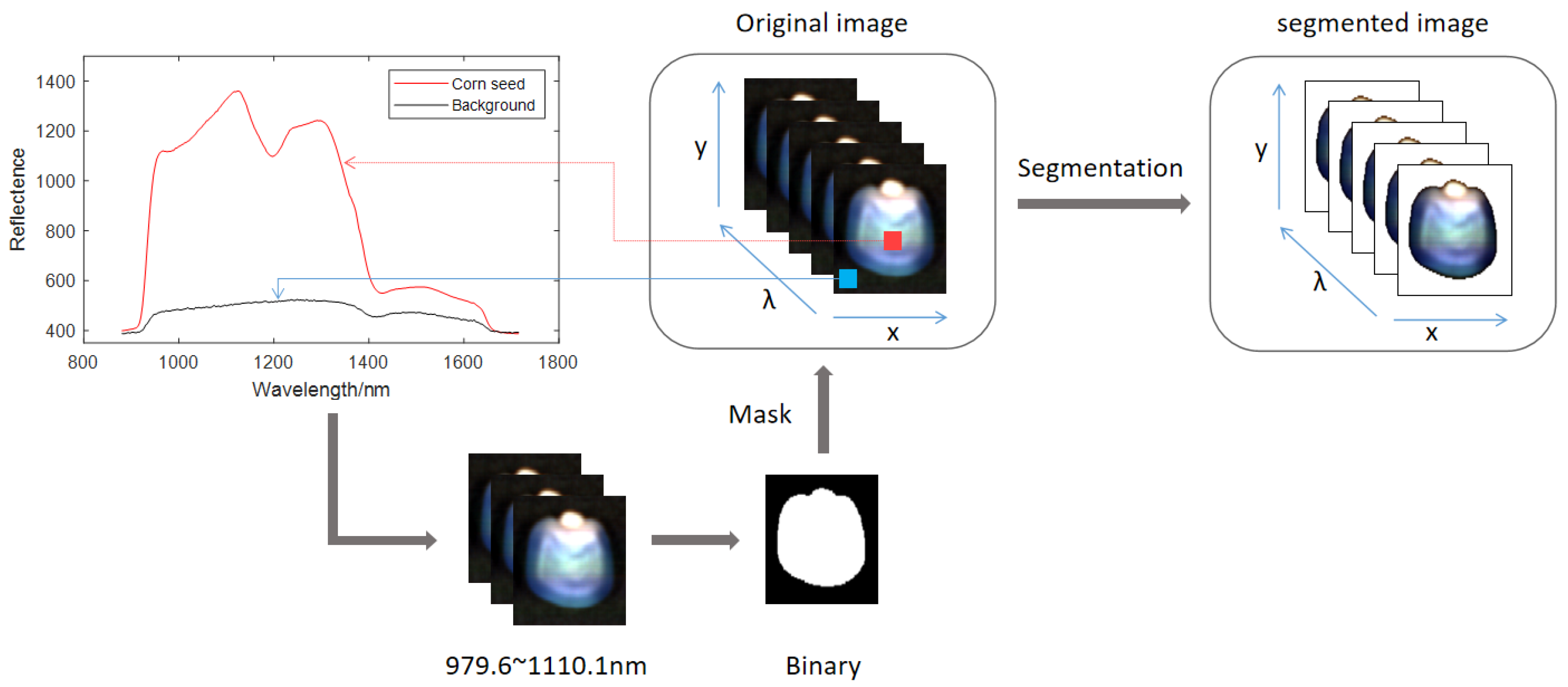
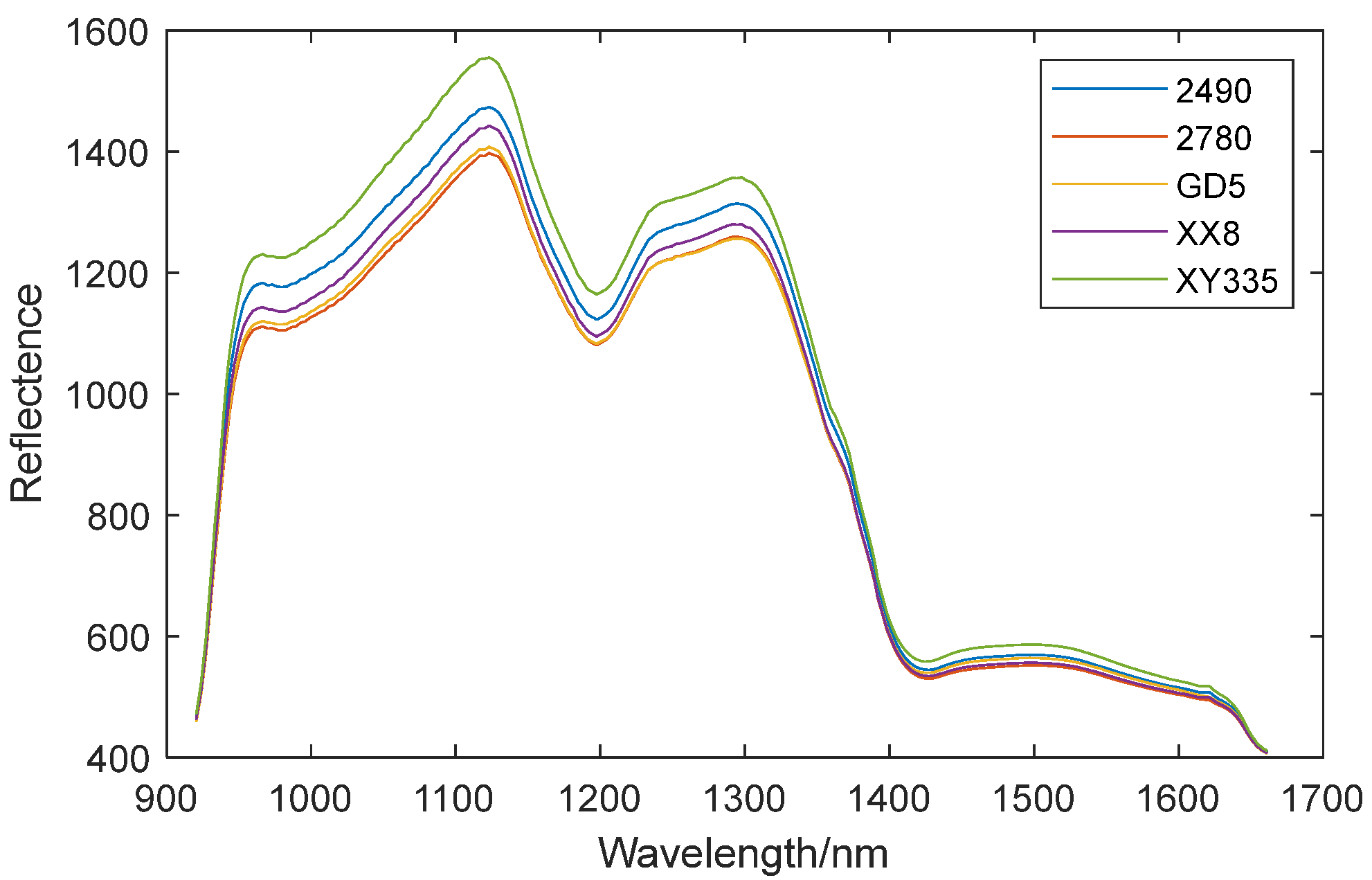

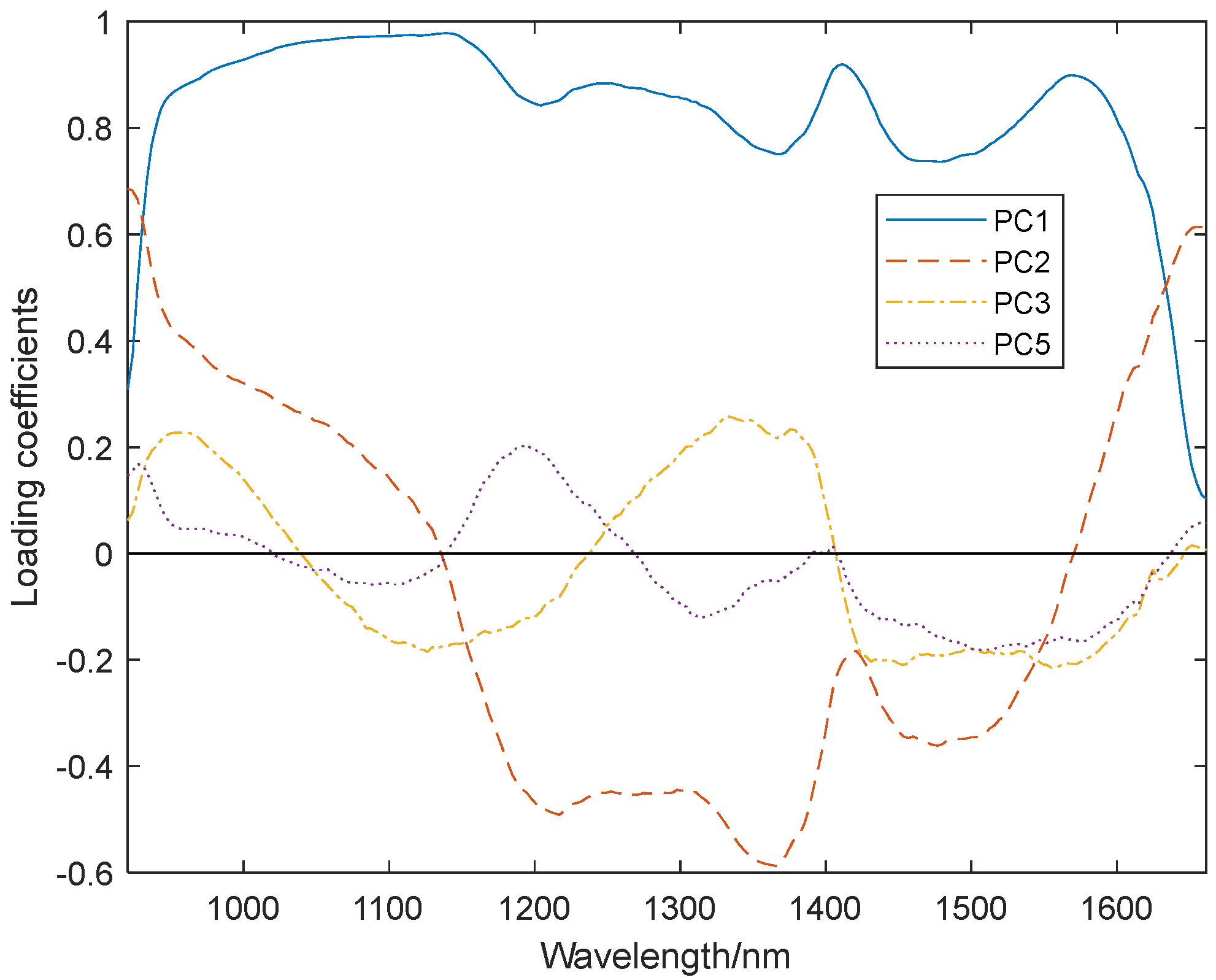
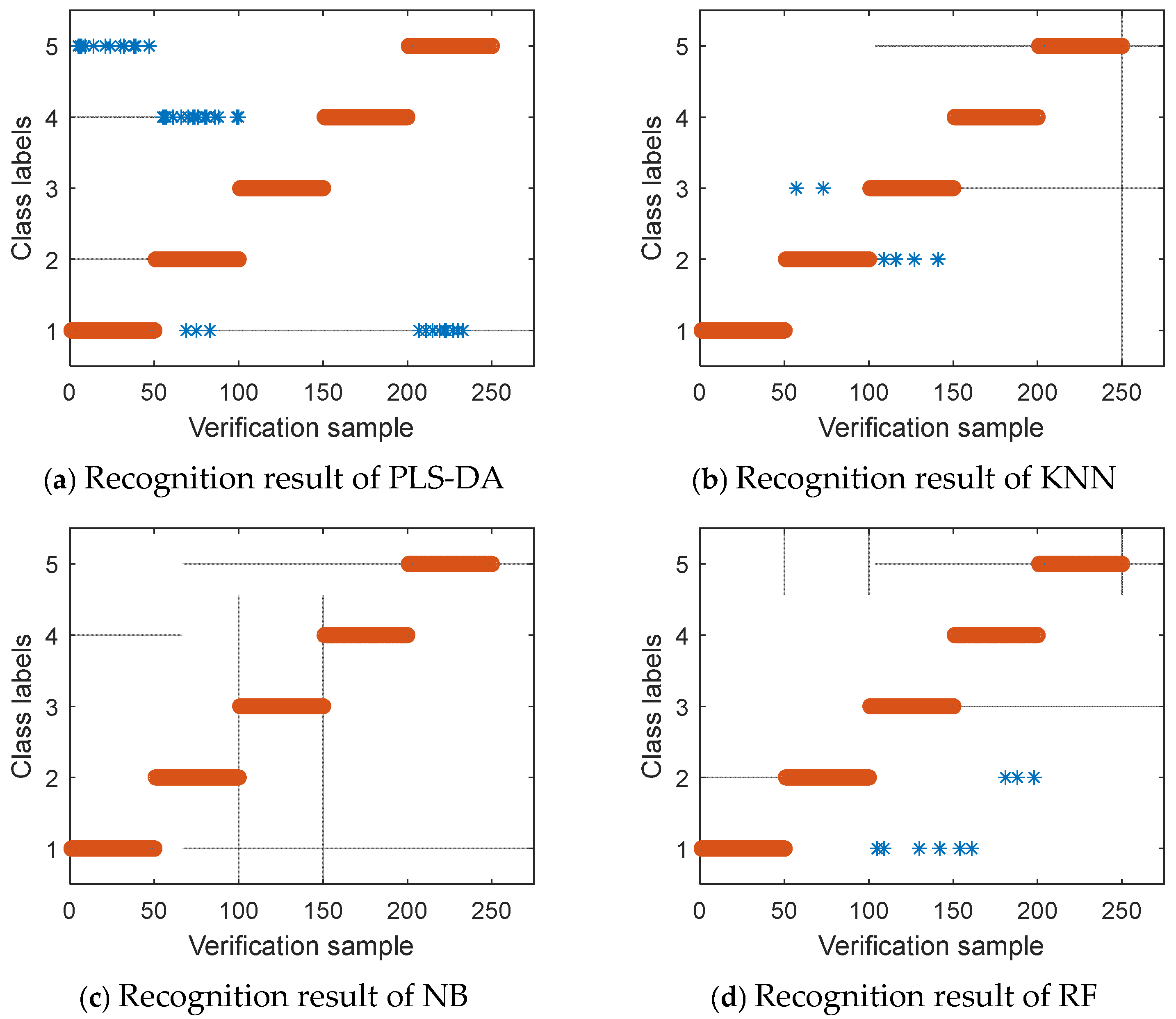


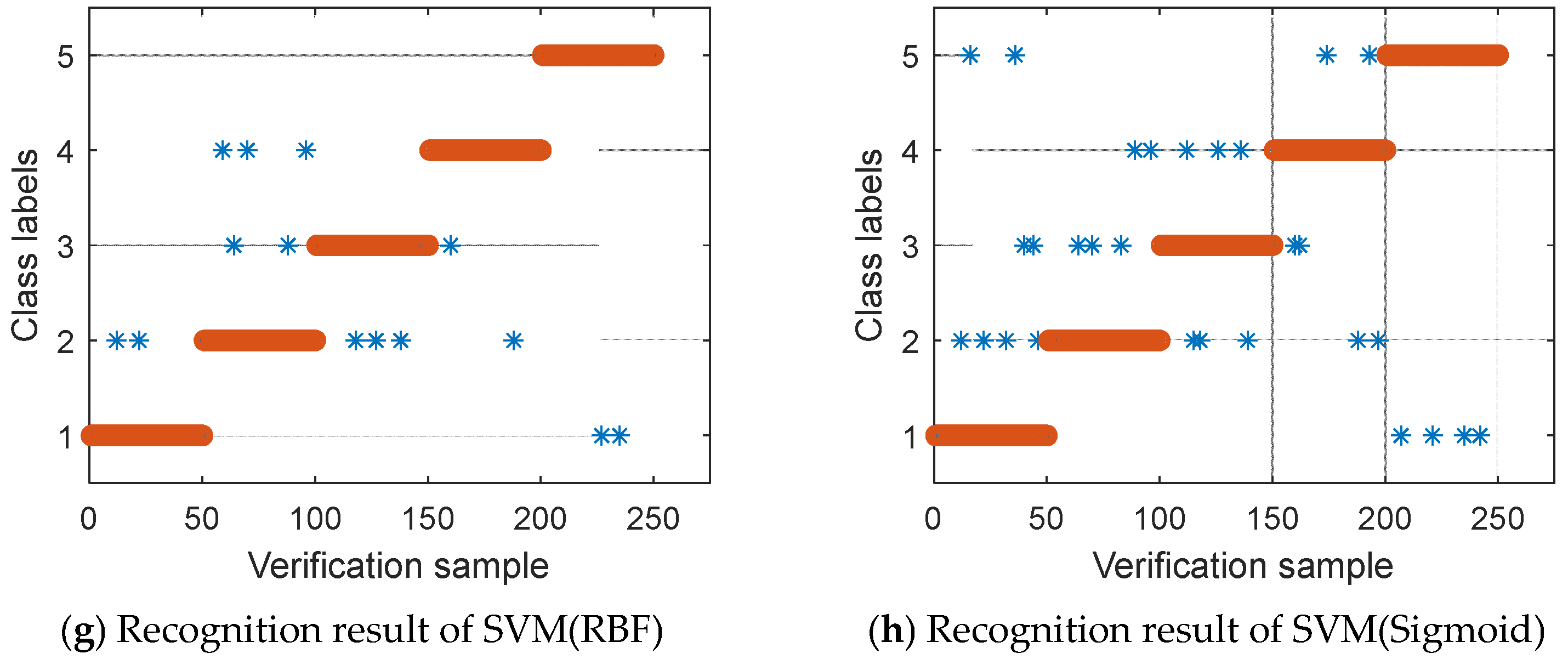
| Kernel Function | Mathematical Formula | Characteristic |
|---|---|---|
| Linear | Few parameters and fast calculation speed | |
| Polynomial | A large number of parameters and easy to overfit | |
| RBF | Wide application and strong locality | |
| Sigmoid | Multilayer neural network |
| Varieties | Assignment | Modeling Set | Prediction Set |
|---|---|---|---|
| 2490 | 1 | 100 | 50 |
| 2780 | 2 | 100 | 50 |
| GD5 | 3 | 100 | 50 |
| XX8 | 4 | 100 | 50 |
| XY335 | 5 | 100 | 50 |
| Recognition Algorithm | Parameter | Modeling Set | Prediction Set | ||
|---|---|---|---|---|---|
| Identification Number | Overall Accuracy/% | Identification Number | Overall Accuracy/% | ||
| PLS-DA | n_components = 10 | 440 | 88 | 211 | 84.4 |
| KNN | n_neighbors = 4 | 490 | 98 | 244 | 97.6 |
| NB | auto | 491 | 98.2 | 250 | 100 |
| RF | ntree = 25 mtry = 11 | 494 | 98.8 | 241 | 96.4 |
| SVM (Linear) | C = 1 | 490 | 98 | 248 | 99.2 |
| SVM (Polynomial) | degree = 3 | 500 | 100 | 250 | 100 |
| SVM (RBF) | C = 84.45 g = 0.001 | 489 | 97.8 | 246 | 98.4 |
| SVM (Sigmoid) | auto | 448 | 89.6 | 228 | 91.2 |
| Recognition Algorithm | Parameter | Modeling Set | Prediction Set | ||
|---|---|---|---|---|---|
| Identification Number | Overall Accuracy/% | Identification Number | Overall Accuracy/% | ||
| PLS-DA | n_components = 8 | 413 | 82.6 | 202 | 80.8 |
| KNN | n_neighbors = 4 | 455 | 91 | 217 | 86.8 |
| NB | auto | 486 | 97.2 | 245 | 98 |
| RF | ntree = 35 mtry = 3 | 491 | 98.2 | 235 | 94 |
| SVM (Linear) | C = 1 | 490 | 98 | 248 | 99.2 |
| SVM (Polynomial) | degree = 3 | 500 | 100 | 250 | 100 |
| SVM (RBF) | C = 10 g = 0.0007 | 489 | 97.8 | 246 | 98.4 |
| SVM (Sigmoid) | auto | 436 | 87.2 | 221 | 88.4 |
| Recognition Algorithm | Overall Accuracy/% | Kappa Coefficient |
|---|---|---|
| PLS-DA | 81.2 | 0.41 |
| KNN | 86.8 | 0.59 |
| NB | 98 | 0.94 |
| RF | 94 | 0.81 |
| SVM (Linear) | 96.8 | 0.9 |
| SVM (Polynomial) | 98.4 | 0.95 |
| SVM (RBF) | 94.4 | 0.83 |
| SVM (Sigmaoid) | 88.4 | 0.64 |
| Recognition Algorithm | 2490 | 2780 | GD5 | XX8 | XY335 |
|---|---|---|---|---|---|
| PLS-DA | 21.43 | 0 | 13.79 | 18.03 | 33.33 |
| KNN | 7.41 | 18.18 | 31.25 | 6.12 | 0 |
| NB | 0 | 9.09 | 0 | 0 | 0 |
| RF | 19.355 | 5.66 | 0 | 0 | 0 |
| SVM (Linear) | 0 | 8 | 2.04 | 5.77 | 0 |
| SVM (Polynomial) | 0 | 4 | 0 | 3.85 | 0 |
| SVM (RBF) | 4 | 11.77 | 6 | 5.88 | 0 |
| SVM (Sigmoid) | 8.7 | 16.67 | 13.73 | 10.2 | 8 |
| Recognition Algorithm | 2490 | 2780 | GD5 | XX8 | XY335 |
|---|---|---|---|---|---|
| PLS-DA | 56 | 26 | 0 | 0 | 12 |
| KNN | 0 | 46 | 12 | 8 | 0 |
| NB | 0 | 0 | 0 | 10 | 0 |
| RF | 0 | 0 | 8 | 16 | 6 |
| SVM (Linear) | 2 | 8 | 4 | 2 | 0 |
| SVM (Polynomial) | 0 | 4 | 4 | 0 | 0 |
| SVM (RBF) | 4 | 10 | 6 | 4 | 4 |
| SVM (Sigmoid) | 16 | 10 | 12 | 12 | 8 |
Disclaimer/Publisher’s Note: The statements, opinions and data contained in all publications are solely those of the individual author(s) and contributor(s) and not of MDPI and/or the editor(s). MDPI and/or the editor(s) disclaim responsibility for any injury to people or property resulting from any ideas, methods, instructions or products referred to in the content. |
© 2023 by the authors. Licensee MDPI, Basel, Switzerland. This article is an open access article distributed under the terms and conditions of the Creative Commons Attribution (CC BY) license (https://creativecommons.org/licenses/by/4.0/).
Share and Cite
Xue, H.; Yang, Y.; Xu, X.; Zhang, N.; Lv, Y. Application of Near Infrared Hyperspectral Imaging Technology in Purity Detection of Hybrid Maize. Appl. Sci. 2023, 13, 3507. https://doi.org/10.3390/app13063507
Xue H, Yang Y, Xu X, Zhang N, Lv Y. Application of Near Infrared Hyperspectral Imaging Technology in Purity Detection of Hybrid Maize. Applied Sciences. 2023; 13(6):3507. https://doi.org/10.3390/app13063507
Chicago/Turabian StyleXue, Hang, Yang Yang, Xiping Xu, Ning Zhang, and Yaowen Lv. 2023. "Application of Near Infrared Hyperspectral Imaging Technology in Purity Detection of Hybrid Maize" Applied Sciences 13, no. 6: 3507. https://doi.org/10.3390/app13063507
APA StyleXue, H., Yang, Y., Xu, X., Zhang, N., & Lv, Y. (2023). Application of Near Infrared Hyperspectral Imaging Technology in Purity Detection of Hybrid Maize. Applied Sciences, 13(6), 3507. https://doi.org/10.3390/app13063507






